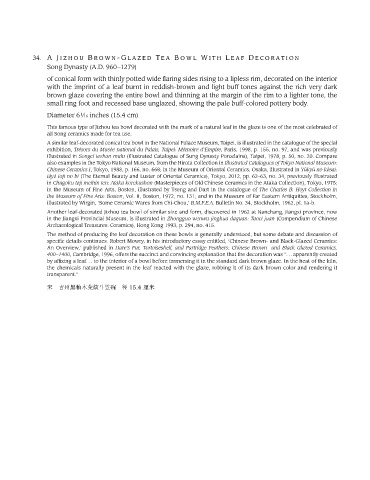Page 67 - Longsdorf Collection of Song Ceramics, 2013, J.J. Lally, New York
P. 67
34. A Jizhou Brown-Glazed Tea Bowl W ith Leaf Decoration
Song Dynasty (A.D. 960–1279)
of conical form with thinly potted wide flaring sides rising to a lipless rim, decorated on the interior
with the imprint of a leaf burnt in reddish-brown and light buff tones against the rich very dark
brown glaze covering the entire bowl and thinning at the margin of the rim to a lighter tone, the
small ring foot and recessed base unglazed, showing the pale buff-colored pottery body.
Diameter 6 ⁄16 inches (15.4 cm)
1
This famous type of Jizhou tea bowl decorated with the mark of a natural leaf in the glaze is one of the most celebrated of
all Song ceramics made for tea use.
A similar leaf-decorated conical tea bowl in the National Palace Museum, Taipei, is illustrated in the catalogue of the special
exhibition, Trésors du Musée national du Palais, Taipei: Mémoire d’Empire, Paris, 1998, p. 155, no. 97, and was previously
illustrated in Songci tezhan mulu (Illustrated Catalogue of Sung Dynasty Porcelains), Taipei, 1978, p. 50, no. 20. Compare
also examples in the Tokyo National Museum, from the Hirota Collection in Illustrated Catalogues of Tokyo National Museum:
Chinese Ceramics I, Tokyo, 1988, p. 166, no. 668; in the Museum of Oriental Ceramics, Osaka, illustrated in Yūkyū no kōsai:
tōyō toji no bi (The Eternal Beauty and Luster of Oriental Ceramics), Tokyo, 2012, pp. 62–63, no. 34, previously illustrated
in Chūgoku tōji meihin ten: Ataka korekushon (Masterpieces of Old Chinese Ceramics in the Ataka Collection), Tokyo, 1975;
in the Museum of Fine Arts, Boston, illustrated by Tseng and Dart in the catalogue of The Charles B. Hoyt Collection in
the Museum of Fine Arts: Boston, Vol. II, Boston, 1972, no. 131; and in the Museum of Far Eastern Antiquities, Stockholm,
illustrated by Wirgin, ‘Some Ceramic Wares from Chi-Chou,’ B.M.F.E.A. Bulletin No. 34, Stockholm, 1962, pl. 1a-b.
Another leaf-decorated Jizhou tea bowl of similar size and form, discovered in 1962 at Nanchang, Jiangxi province, now
in the Jiangxi Provincial Museum, is illustrated in Zhongguo wenwu jinghua daquan: Taoci juan (Compendium of Chinese
Archaeological Treasures: Ceramics), Hong Kong 1993, p. 294, no. 415.
The method of producing the leaf decoration on these bowls is generally understood, but some debate and discussion of
specific details continues. Robert Mowry, in his introductory essay entitled, ‘Chinese Brown- and Black-Glazed Ceramics:
An Overview,’ published in Hare’s Fur, Tortoiseshell, and Partridge Feathers: Chinese Brown- and Black-Glazed Ceramics,
400–1400, Cambridge, 1996, offers the succinct and convincing explanation that the decoration was “. . . apparently created
by affixing a leaf. . . to the interior of a bowl before immersing it in the standard dark brown glaze. In the heat of the kiln,
the chemicals naturally present in the leaf reacted with the glaze, robbing it of its dark brown color and rendering it
transparent.”
宋 吉州黑釉木葉紋斗笠碗 徑 15.4 厘米

